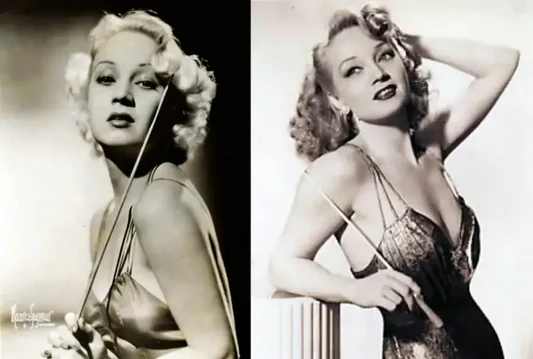Critical Race Theory’s Bombshell
I am awed by the raw talent of one of the first female big band leaders from the 1930’s who commanded an orchestra while tapping and singing “Truckin” in a tight black dress that binds her legs. Ina Ray Hutton, at eighteen led a band in 1934, making her one of the first female band leaders and one of the first entertainers with an all female band.
Fascination with this almost forgotten star inspired research into her music and life, which is limited despite her fame throughout the thirties and forties. The Guardian reporter Bob Stanley wrote a piece in 2011 that discusses the possibility that her lack of albums likely drifted this talented performer into obscurity. Eye-rolling critics perceiving Hutton as glam music of the day possibly added to her lost history by causing Hutton to disband her all female orchestra to create an all male ensemble in 1939.
Phyllis Fletcher discovered Hutton’s secret in 2007 when she happened to notice a CD cover that featured two contrasting images of Hutton: one as a voluptuous blonde, and the other side as a brunette.
“That chick is black,” Fletcher thought, which proved correct with her research into Census records that revealed Hutton born in a black, south Chicago neighborhood. Hutton’s birth record listed her as “negro” and “mulatto” in 1916 with the name Odessa Cowan.
Hutton began her career as a singer and dancer in Broadway shows and vaudeville acts. She changed her name to Ina Ray and later added Hutton to capitalize on the fame of Barbara Hutton, a wealthy socialite.

In 1934, Hutton formed the Melodears, one of the first all-female swing bands. She was known as the “Blonde Bombshell of Rhythm” for her glamorous outfits and energetic performances. She and her band appeared in films, radio shows, and recordings.
Hutton chose to “pass” as white throughout her musical career, hiding her Black ancestry from the public and the entertainment industry never revealing her heritage. “Passing” was a strategy used by some Black people to circumvent discrimination and harassment. However, passing held many dangers at the time if discovered or suspected, leading to loss of career, associates, and opportunities. Passing may have allowed Hutton to perform, but her love of entertainment must have been great because passing incurred a loss of identity and community.
In the United States, passing has a complex history among African Americans going all the way back to those passing as white to escape slavery, segregation, and violence. This practice sparked controversy as it can be viewed as resistance to racism, yet also as reinforcing white power and privilege. Hutton is a notable example of passing, which shows the systemic nature of racism in the United States.
The Hutton CRT Lesson
The fact that Blacks resorted to passing to avoid discrimination and obtain opportunities evidences the fact that white privilidge and power were systemic and woven into society, culture, and law.
Opponents of Critical Race Theory (Republicans) like to pretend that Blacks exaggerate racism and social inequality, using it as an excuse for not working hard enough, laziness, or failing to try harder to succeed. The fact remains that passing is very much a real consequence of the systemic racism that inhibited the opportunities for an entire population. Hutton is an important figure in the fight to maintain Critical Race Theory in education because her choice to “pass as white” is the undeniable result of generations of prejudice.
Why else would she choose passing?
CRT has been attacked by Republicans for a host of reasons that boil down to racism or prejudice, threatening to erase the struggles and sacrifices of people like Hutton and all civil rights progress. Conservatives perceive CRT as a threat, especially lessons like the one Hutton’s life and career teach. They have enacted laws in various states, banning the teaching of critical race theory, but these acts hide a more hideous truth. Those who ban CRT are not trying to protect history but instead maintain the privilidge and power threatened by teaching people the truth about systemic racism. When we study Hutton’s story, we clearly see not just the struggle for equality but also the vital need for CRT.
See, Republican, your head didn’t explode and you made it all way through your first CRT lesson. Hopefully, you learned something.
For further reading:
The Blonde Bombshell of Rhythm
INA RAY, NÉE ODESSA COWAN HUTTON (1916–1984)
 Question? Comment? Rebuttal?
Question? Comment? Rebuttal?Copy the article's title or link to send with your response.




